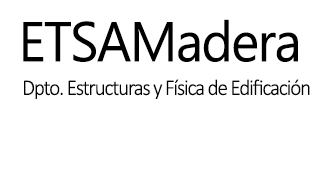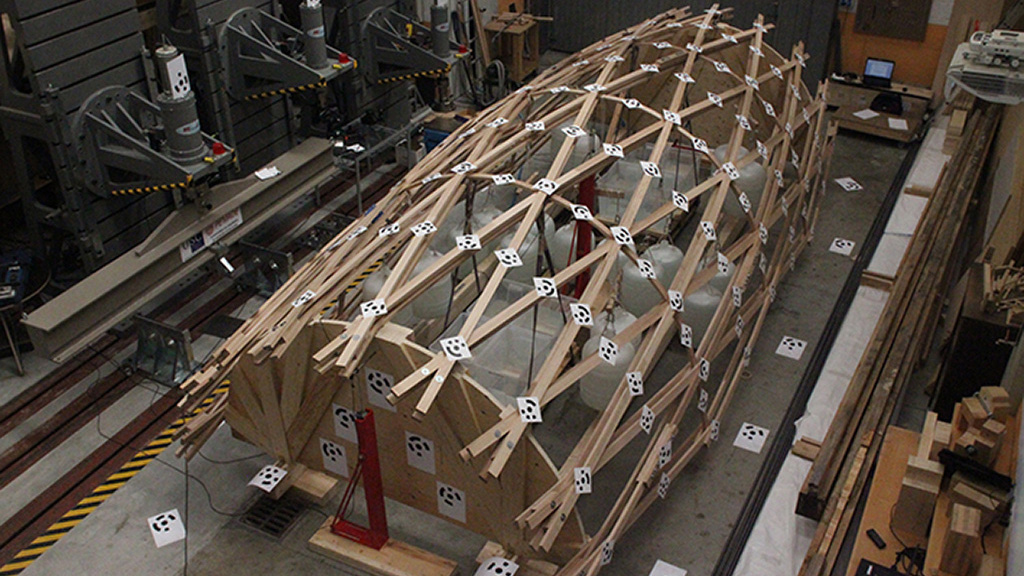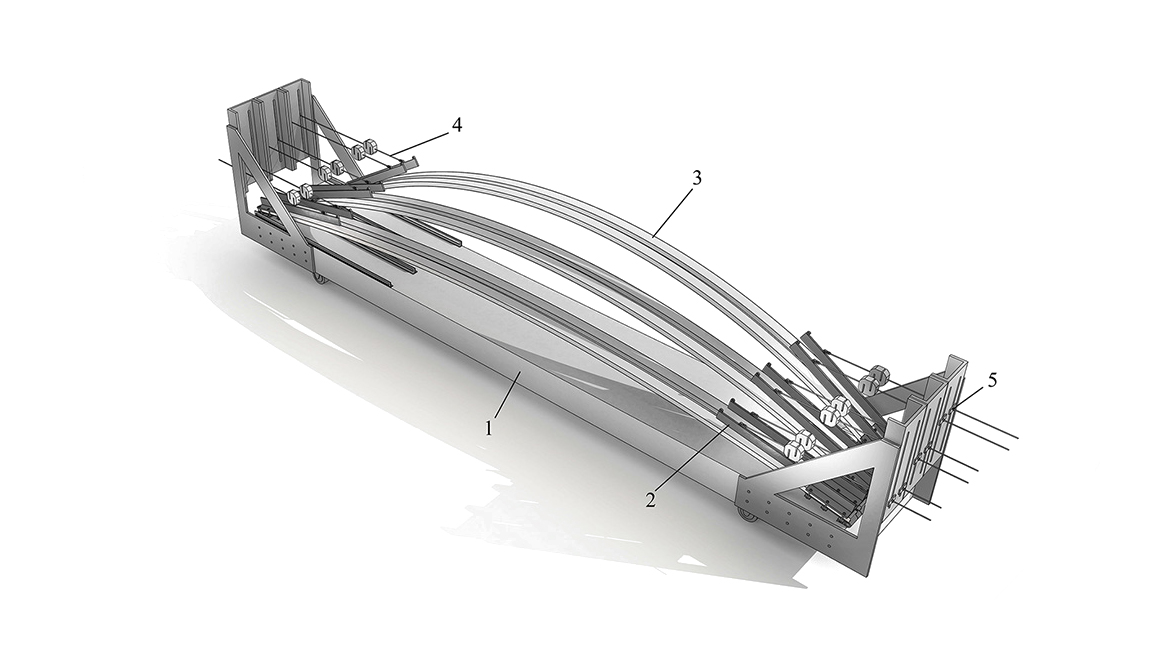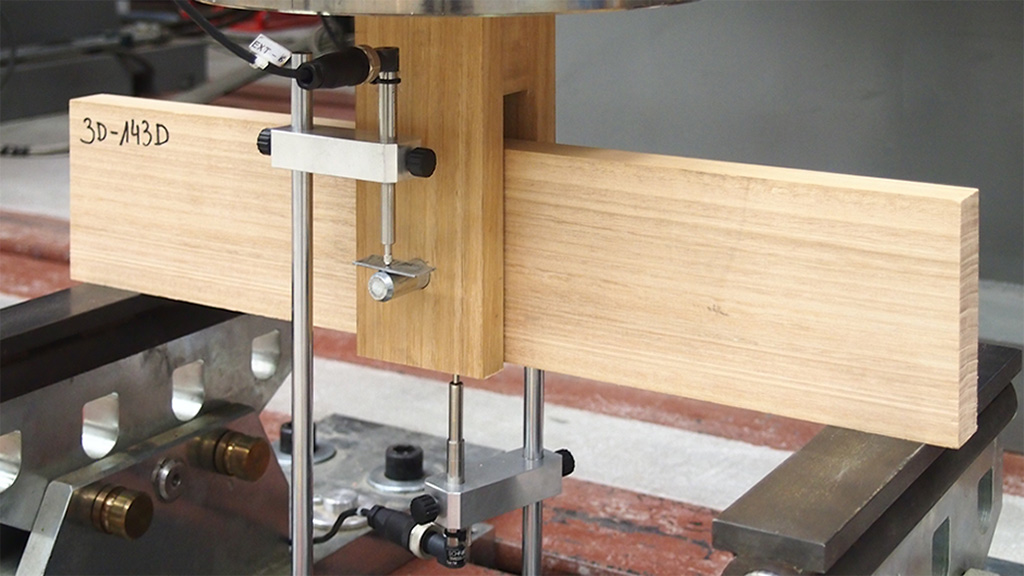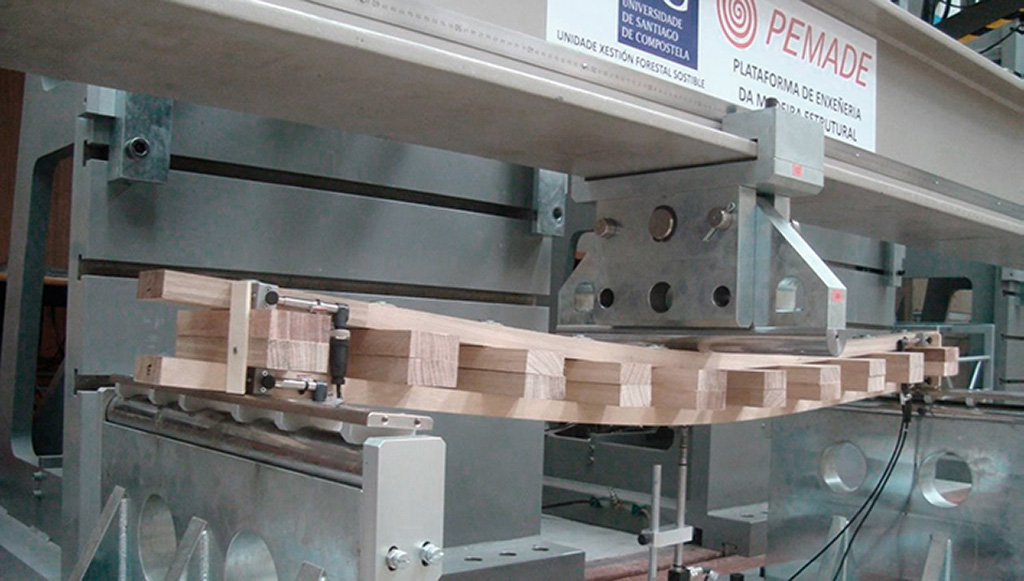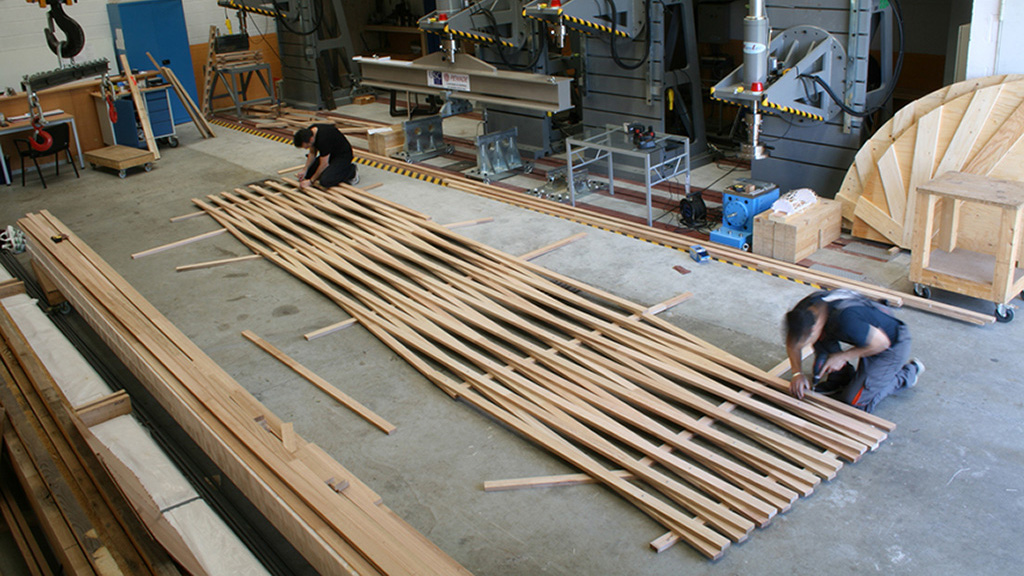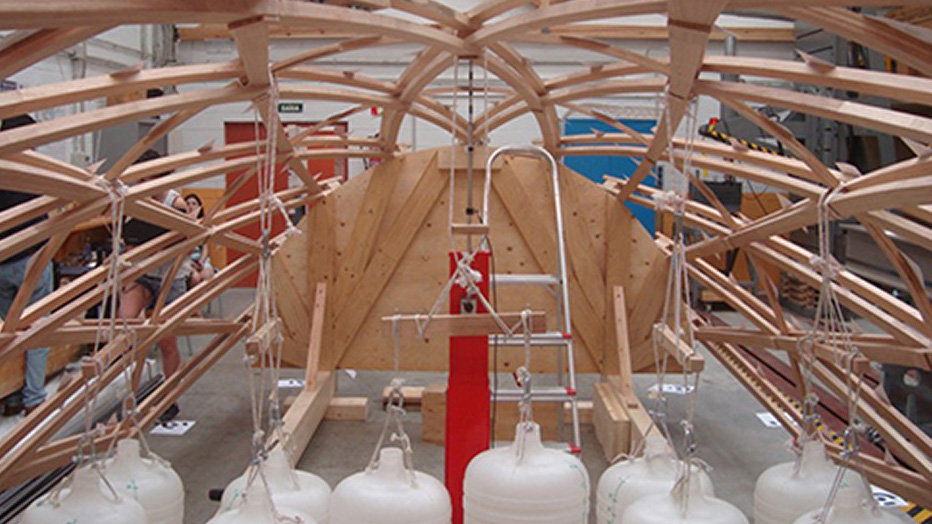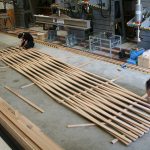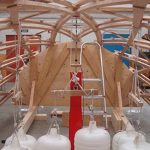Title (acronym): Analysis of the stress relaxation in curved members and new joints solutions for timber Gridshells made out of Eucalyputs globulus (EUCAGRID)
Reference: BIA2015-64491-P
Funding: National Program for the Promotion of Scientific and Technical Research of Excellence, National Subprogram for Knowledge Generation, Spanish Ministry of Economy and Competitiveness.
Duration: 3 years (01/01/2016 – 31/12/2018).
Budget: 86.515,00 €
Financed amount: 71.500,00 €
Principal Research: Dr. Manuel Guaita Fernández
Research Team
University of Santiago de Compostela:
- Dr. Manuel Guaita Fernández
- Dr. Antonio José Lara Bocanegra
- Dr. Juan Ortiz Sanz
- Dr. Guillermo Riesco Muñoz
- Dr. María José López Villar
- Dr. Rubén Regueira Gay
- Dr. Jorge Crespo Outes
Technical University of Madrid:
- Dr. José Luis Fernández Cabo
- Dr. Almudena Majano Majano
University of Seville:
- Dr. Narciso Jesús Vázquez Carretero
University of Extremadura:
- Dr. José Ramón Villar García
University of Tras-os-Montes e Alto Douro
- Dr. José Joaquim Lopes Morais
- Dr. José Manuel Cardoso Xavier
- Dr. Nuno Miguel Magalhães Dourado
Abstract
The sustainable and environmentally friendly construction is no longer a value-added to become a requirement of our society. Timber construction is experiencing a boost in Europe due to the environmental advantages of over other materials.
The emergence of new products and wood-based systems along with the evolution of structural analysis tools is causing hitherto unthinkable developments, such as multi-storey buildings and shell structures.
Shell structures are a very efficient structural type which acquires strength and stiffness because of its shape. The main drawback is that this geometry, usually irregular, often implies the construction of singular elements with the consequent impact on the implementation costs.
The gridshell technique allows to build long span timber shells structures with double curvature from standard elements. This technique is based on the on site bending of flat grids made of identical elements of good quality solid wood, great length and small section, constituting a system with high capacity of industrialization and standardization.
However, despite the enormous potential of the gridshell technique, just some unique works have been built following this structural type due to important scientific and technical difficulties that hinder its use. In particular, the lack of studies on the stress relaxation that occurs in timber elements with large curvatures, the necessary development of specific joint systems, the lack of adequate commercial wood products, and the lack of research on numerical models experimentally contrasted are several aspects that make difficult the implementation and development of this interesting structural system.
This project aims to create knowledge about these issues in order to achieve the implementation of gridshells made out of national wood species of high performance. In particular, the proposed research aims to deepen the understanding of the mechanical and structural properties of Eucalyptus globulus for its innovative implementation in such structures. For this purpose, the stress relaxation of the curved elements and two novel joint solutions will be numerically and experimentally analyzed. In addition, two full scale prototypes of gridshells will be tested, which will be useful for validating a new numerical model including the elastoplastic behavior of the joints, the bending stress and its relaxation, and the multilayer characteristic geometry of gridshells.
The research will be complemented by the innovative development of a lath finger-joint for Eucalyptus globulus necessary to get elements of great length.
Finally, as part of the dissemination strategy, a practical application of the developed research will be done by building a gridshell of ecualyptus for a parking cover. This action will extend the investigation beyond the project time limits by the monitoring of its long-term evolution and behavior.
Related publications
-
Lara Bocanegra, A.J. (2023) Obra nueva. Prototipo de cubierta-gridshell en PEMADE-USC. En: Guía técnica de Soluciones innovadoras en madera Estructural en la arquitectura gallega actual, Ed. Agencia Gallega de la Industria Forestal. Consellería del Medio Natural. Xunta de Galicia Pp. 36-41. Depósito legal: C-2156-2022
-
Lara Bocanegra, A.J. (2023) Obra nueva. Edificio impulso verde. En: Guía técnica de Soluciones innovadoras en madera Estructural en la arquitectura gallega actual, Ed. Agencia Gallega de la Industria Forestal. Consellería del Medio Natural. Xunta de Galicia Pp. 18-23. Depósito legal: C-2156-2022
-
Majano-Majano A, Lara-Bocanegra AJ, Xavier J, Guaita M. (2022) Splitting capacity of Eucalyptus globulus beams loaded perpendicular to the grain by connections. Materials and Structures (2022) 55:147
-
Lara-Bocanegra AJ, Majano-Majano A, Ortiz J, Guaita M. (2022) Structural Analysis and Form-Finding of Triaxial Elastic Timber Gridshells Considering Interlayer Slips: Numerical Modelling and Full-Scale Test. Applied Sciences 12, 5335
-
Majano-Majanoa A, Lara-Bocanegra AJ, Xavier J, Pereira F, Morais J (2022) Direct evaluation of mode I cohesive law of eucalyptus bonded joints. Procedia Structural Integrity 37 (2022) 492–499
-
Majano-Majano A, Lara-Bocanegra AJ, Xavier J, Pereira F, Morais J. (2021) Direct evaluation of Mode I cohesive law of eucalyptus bonded joints. International Conference on Structural Integrity (ICSI), Funchal, Madeira, Portugal.
-
Lara-Bocanegra AJ, Majano-Majano A, Arriaga F, Guaita M. (2020) Eucalyptus globulus finger jointed solid timber and glued laminated timber with superior mechanical properties: Characterisation and application in strained gridshells. Construction and Building Materials, 265:120355.
-
Crespo J, Majano-Majano A, Lara-Bocanegra AJ, Guaita M. (2020) Mechanical properties of small clear specimens of Eucalyptus globulus Labill. Materials, 13(4):906.
-
Majano-Majano A, Lara-Bocanegra AJ, Xavier J, Morais J. (2020) Experimental Evaluation of Mode II fracture Properties of Eucalyptus globulus L. Materials, 13(3):745.
-
Majano-Majano A, Lara-Bocanegra A.J, Xavier J, Morais J. (2019) Measuring the cohesive law in mode I loading of Eucalyptus globulus. Materials, 12(1):23.
-
Lara-Bocanegra A, Roig A, Majano-Majano A, Guaita M. (2019) From eucalyptus to elastic gridshells. Form and Force. 60th Anniversary Symposium of the Association for shell and spatial structures (IASS), Barcelona, Spain.
-
Lara-Bocanegra AJ, Majano-Majano A, Arriaga F, Guaita M. (2018) Long-term bending stress relaxation in timber laths for the structural design of lattice shells. Construction and Building Materials, 193:565-575.
-
Crespo J, Majano-Majano A, Xavier J, Guaita M. (2018) Determination of the resistance-curve in Eucalyptus globulus through double cantilever beam tests. Materials and Structures, 51(3):77.
-
Xavier J, Majano-Majano A, Lara-Bocanegra AJ, Guaita M. (2018) Identification of bending stiffness parameters of Eucalyptus globulus from the virtual fields method. 11º National Congress on Experimental Mechanics (CNME) & 1º Iberian Congress on Theoretical and Experimental Mechanics and Materials (TEMM), Porto, Portugal.
-
Lara-Bocanegra AJ, Majano-Majano A, Ortiz J, Guaita M. (2018) Full scale laboratory prototype of a long barrel-vaulted gridshell. Construction, testing and numerical model. World Conference on Timber Engineering (WCTE 2018), Seoul, Republic of Korea.
-
Majano-Majano A, Lara-Bocanegra AJ, Xavier J, Morais J. (2018) Experimental research on hardwood connections loaded perpendicular to the grain. World Conference on Timber Engineering (WCTE 2018), Seoul, Republic of Korea.
-
Lara-Bocanegra A, Majano-Majano A, Crespo J, Guaita M. (2018) Dispositivo para ensayos de relajación de tensiones a flexión en láminas de madera curvadas con radio constante (Test device for bending stress relaxation in curved timber laths under constant radius). Patent with examination. ES 2 649 543 A1.
-
Lara-Bocanegra A.J, Majano-Majano A, Guaita M. (2017) Stress relaxation on bending laths: review of test procedures and structural analysis approaches applied to timber gridshells. II Latin American Congress of Timber Structures + II Ibero-Latin American Congress of Timber in Construction (CLEM+CIMAD 2017), Buenos Aires, Argentina.
-
Lara-Bocanegra AJ, Majano-Majano A, Ortiz J. Guaita M. (2017) Elastic gridshell prototype made of Eucalyptus globulus: construction and laboratory test. II Latin American Congress of Timber Structures + II Ibero-Latin American Congress of Timber in Construction (CLEM+CIMAD 2017), Buenos Aires, Argentina.
-
Lara-Bocanegra AJ, Majano-Majano A, Crespo J, Guaita M. (2017) Desarrollo de láminas reticulares postconformadas con madera de Eucalyptus globulus. Congreso de Ingeniería Rural, Madrid, Spain.
-
Crespo J, Aira JR, Vázquez C, Majano-Majano A, Guaita M. (2016) Determination of the elastic constants in Eucalytpus globulus by ultrasound and mechanical tests. World Conference on Timber Engineering (WCTE 2016), Vienna, Austria.
